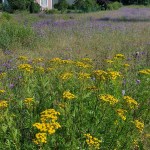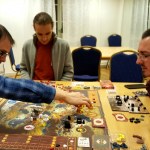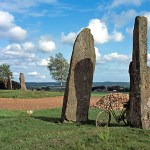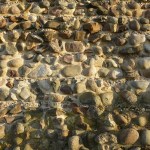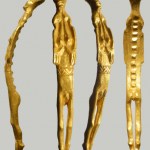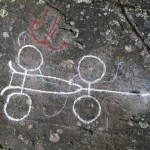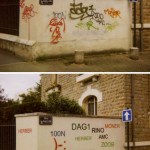Art
Reading Matt Ruff's new novel about black Americans in the 50s. Annoyed to find that nothing in the dialogue would sound out of place if spoken by a white American sci-fi fan in 2017.
Feared 45 would be the sort who gets the trains running on time and starts wars. Actually can't get trains running at all, wars with TV hosts.
Etymological misunderstanding in this novel. Ruff parses the name Braithwaite as Braith-white, when it is actually Brae-thwaite.
There's this book about edible wild plants in Sweden named "Can you eat these things?" A more important question is "What population…
"Ways of knowing" = alternative facts.
I am on a WorldCon panel about the Medieval mind and fantasy literature. I just had the (unoriginal) idea to say that the High and Late Medieval aristocracy lived largely in an Arthurian fantasy world of their own creation.
Last night a skinny cat came miaowing at our door. Turned out to have left his home 200 m from us a week ago. With no sense of direction. And no hunting skills. He's back with his kind owners now.
I've bought a lot of ebooks from Google. I would happily continue to do so even though now I've got a Kindle, because Google has much…
This past weekend saw my seventh annual boardgaming retreat: 43 hours in good company at a small hotel (in Nynäshamn for the first time), all meals included. My buddy Oscar organises everything. This year we broke the attendance record, with 28 participants, mainly guys in our 30s and 40s. Before Sunday lunch I left early and went to the release event for Karin Bojs and Peter Sjölund's interesting new book on X-chromosome haplotypes, Swedish male-line descent and genealogy: Svenskarna och deras fäder, “The Swedes And Their Fathers”.
I played thirteen sessions of ten different games in…
In the old days, the words "art" and "science" did not mean the same thing they mean today, at least in academia. Today, unfortunately, they have almost come to mean opposites. You can't be doing both at once. Or, at least, that's what people who haven't thought about it much may think.
Art can be used to engage people in science, and science can provide a subject for art, and in various ways, the twain shall meet.
But in Reductionism in Art and Brain Science: Bridging the Two Cultures, Erik Kandel does something both more extreme and more specific than simply joining the two endeavors.…
Like Romanticism, Post-Modernism is a poorly defined term that means different things in different contexts. But in academe, pomo can pretty much be equated with relativism. This term also means several different things, but all of them apply to pomo.
The relativism that makes me hostile to pomo is knowledge relativism or epistemological relativism. “All statements of fact are historically and culturally situated and thus meaningless outside a local contemporary sphere”. This stance can be applied to itself and immediately yields absurdity.
The other pomo relativism is aesthetic. “All value…
Two strap ends from the eponymous Borre ship grave. Image from Oluf Rygh's 1885 Norske Oldsager.
Metal detectorist Steffen Hansen has kindly given me permission to show you his tattoo sleeve. He found the strap-end at Øvre Eiker in Buskerud fylke, Norway, and had it tattooed along with other Norwegian examples of the Borre style. I haven't got a picture of his find, but you can see what they look like in the accompanying picture of a piece from the eponymous find at Borre in nearby Vestfold fylke. The tattoo was done by Mikael "Kula" Jensen of Radich Tattoo in Mjøndalen.
The Borre style is…
Sweden's bedrock has been entirely abraded by the inland ice. It sanded down the country like a big wood planer, leaving smooth lovely outcrops known as hällar all over the place. This is the main natural prerequisite of Sweden's rich rock art tradition. Most of it dates from the Bronze Age, 1700–500 BC.
Denmark hardly has any visible bedrock, so they don't have much rock art over there, and what they do have tends to be on boulders. It is thus hardly surprising that when you do find figurative art on boulders in Sweden, it tends to be in the provinces closest to Denmark.
Near Asige church in…
I spent last week in Denmark at a friendly, informative and rather unusual conference. The thirteenth Castella Maris Baltici conference (“castles of the Baltic Sea”) was a moveable feast. In five days we slept in three different towns on Zealand and Funen and spent a sum of only two days presenting our research indoors. The rest of the time we rode a bus around the area and looked at castle sites and at fortifications, secular buildings, churches and a monastery in four towns. Our Danish hosts had planned all of this so well that the schedule never broke down. Add to this that the food and…
Taxidermy is art, and art can be disquieting. I think Kate Clark is doing some amazing art here.
The Archangel Raphael. Recently uncovered mural in Kil church, Närke. C. 1250.
Today's my 16th anniversary as editor of Fornvännen! Issue 2014:3 is now on-line on Open Access.
Ole Thirup Kastholm on dugout canoes from before AD 1 on the Scandinavian peninsula.
Ole Stilborg on Late Bronze Age pottery from Östergötland.
Peter Tångeberg on recently uncovered Medieval murals in Kil church, Närke.
Påvel Nicklasson on early 19th century archaeological innovator Sven Nilsson’s female correspondents and on hints that Nilsson may have turned to folk magic when seasick.
Olof Holm on Iron Age metal…
Modern science stands on the shoulders of giants, as well as average humans, dwarves and elves, ancient civilizations, and all the bones of the dead—forgotten and otherwise. But sometimes you have to start a new branch of science from scratch. On Uncertain Principles, Chad Orzel continues his count-up to Dec. 25, the birthday of Sir Isaac Newton. Orzel explores the origins of agriculture in the Americas, where nativized people made the best of their local flora, turning a humble, nearly inedible grass into one of the biggest food staples on Earth. Chad writes, "Our other staple crops are also…
Fornvännen 2013:4 is now on-line on Open Access.
Ulf Ragnesten on an ornate late-1st millenium BC bronze chain belt from a cremation grave in a Gothenburg suburb.
Lars Larsson and Bengt Söderberg on recent excavations at the huge 1st millennium AD royal manor complex of Uppåkra, with in situ arson victims found among the building remains. (Just like what has more recently been found at Sandby fort on Öland!)
Pia Bengtsson Melin on recently found Romanesque mural fragments in Marka church in Västergötland.
Anders Högberg et al. on scientific characterisation of flint from Polish and South…
Solar cells made with bismuth vanadate achieve a surface area of 32 square meters per gram. This compound can be paired with cheap oxides to split water molecules (and make hydrogen) with record efficiency.
Short-term geoengineering could postpone global warming, only to have it happen more quickly in the future.
Carotenoids tinge blackbird bills a deep orange, signalling fitness; birds with oranger bills are "are heavier and larger, have less blood parasites and pair with females in better condition than males with yellow bills."
Fibroblasts can extrude a tidy biological…
As an alternative to biblical creationism, Intelligent Design infers a less obtrusive God to explain life on Earth. This deity doesn't hurl bolts of lightning, unless it's with the express purpose of sparking abiogenesis in the primordial soup. On EvolutionBlog, Jason Rosenhouse dismisses probabilistic arguments against the likelihood of complex organisms, explaining that even the most improbable-seeming outcome of natural selection is more or less inevitable. As a flawed analogy, he imagines flipping a coin 500 times. This will always manifest a sequence of heads and tails that only had…
To help people understand that this is a coffee cup, we have decided to decorate it with instructive pictures of coffee cups.
As my buddy Marcus Widengren commented, "Now they only have to add the words 'This is not a coffee cup' and take Magritte to the next level."
Smørenge is one of the sites on Bornholm that keeps yielding mid-1st-millennium gold mini-figurines. But in addition to the 2D representations on embossed gold foil known as guldgubber, an artisan employed by the magnate family at Smørenge also made nude 3D figurines. The fifth of these was found by one of the island's famously skilful metal detectorists in May, and she's quite a revelation. Because representations of women are far less common than of men in Iron Age art, and nude women are almost unknown.
The Smørenge woman is wearing only a hatched belt. She has the prominent "seer's thumbs…
Bronze Age rock art along Sweden's south-east coast is rich but not as varied as that of the famous west-coast region. One motif that we have been missing is the four-wheel wagon. It isn't common anywhere except on one site, Frännarp in inland Scania (below right), but we have had none whatsoever where I am.
Wagons at Frännarp in Scania
The other day we got our first wagon: at the rich classical site of Himmelstalund on the outskirts of Norrköping in Östergötland province. According to period convention, it is depicted in a flattened perspective with the wheels seen from the sides and the…
I stumbled across this image by Wikipedia contributor Tauʻolunga whilst researching constellations for a tattoo I'm musing upon. It shows Sun's apparent path across the heavens. I think it would look great as a ring or a bracelet!
Wikimedia Commons
The Weburbanist has a nice spot on French artist Mathieu Tremblin, who explores the boundary between digital and real world art.
Mathieu Tremblin - http://www.demodetouslesjours.eu/
I adored this huge rendering of the Getty Images watermark across a car park wall. As Weburbanist points out, the work sits in some digital/real world uncanny valley:
[Tremblin] spoofs the ubiquity of digital watermarks by photographing a physical equivalent straight-on. We are so used to seeing these as after-print overlays on pictures, it takes conscious effort to realize it is part of the actual…
Move over, Rotwang: this femme-domme-themed mad scientist magazine by artist Sardax got a chuckle out of me. Why should mad scientists always be male, pale and stale?
Credit: Sardax.com
Hat tip Mika Tan

